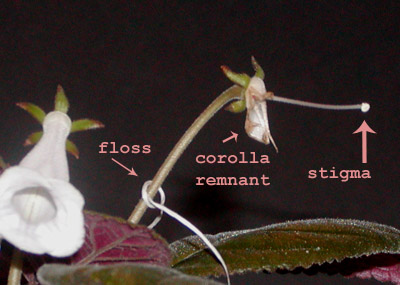| Species list |
Hybrids list |
Tubers list |
Topics list |
Site index |
What's new |
Home page |
Everybody who hybridizes has a favorite way of doing it. What works for one person will seem too much trouble or too slapdash to another. Here's how I do the deed, but it is far from the only way.

The picture to the right shows the essentials. The flower was prepared about three days before this photo. I made a careful, lengthwise slit on the bottom of the corolla, pulled it open, and cut off the immature anthers. (The next time I do it, I'll take a picture.)
The remnant of the corolla hangs from the base of the flower and the calyx. One of the amputated filaments (the stalks that hold the anthers) can be seen to the bottom right of the corolla. The now-mature stigma is ready to receive pollen.
When I prepared the flower, I tied a piece of dental floss loosely around the pedicel. This, together with the corolla fragment, marks the flower I prepared, so I can find it again a few days later. When I apply the pollen, I record the plant, the pollen donor, and the floss color in a computer log, so that many weeks later, I will be able to tell who the parents were.
I got the floss idea from Jon Dixon, but he denies this, and says he got it from me!
The plant in this case is Sinningia 'Texas Zebra' x 'Peninsula Belle', the first one of that crop to flower. There is also a picture of this plant in an earlier state -- a much much earlier state!
The pollen donor here is S. guttata. This is a "wide" cross; the pollen donor and the pollen recipient are in very different branches of the genus Sinningia. Consequently, any progeny from this cross will almost certainly be sterile. In making a wide cross that will produce sterile plants (if any), I prefer to use a hybrid, the more complex the better, as one of the parents. This provides the best chance at a variety of plants. Crossing two species to get a sterile plant means that the offspring will be pretty much all alike, so that if the hybrid plant has a defect, there's no way to get rid of it by further hybridizing.